|
Agility Auto Parts is offering RockAuto customers an exclusive 10% Instant Rebate on their A/C Condensers throughout the month of July 2023. Agility Auto Parts offers a complete line of automotive condensers covering over 95% of all North American vehicle applications. Engineered and manufactured under ISO 9001 / TS16949 quality standards, Agility condensers utilize superior quality parts that meet or exceed OE specifications. Agility condensers are available for both R12 and R134A refrigerants for easy installation into your original A/C system. Why Replace the A/C Condenser? 1996 and newer A/C Condenser designs are difficult (often impossible) to thoroughly flush, because of their small, multi-pass tube construction. A partially clogged or contaminated A/C Condenser can force your compressor to work harder, and lead to premature failure. While shopping, simply add an Agility A/C Condenser (marked with a "Promotion/Rebate" | |
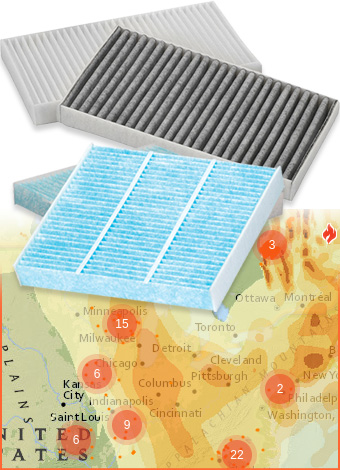 Are the ongoing Canadian wildfires affecting the air quality in your area? With hundreds of wildfires actively burning and expected to continue throughout the summer, consider replacing your Cabin Air Filter now, to help protect you and your passengers from dangerous particles found in the drifting smoke. Even if the smoke has cleared, your Cabin Air Filter may be clogged or extra dirty after working overtime to filter the outside air pollution. When shopping, consider a filter listed as Electrostatic Particulate or Multi-Layer for extra protection. These filters' media is designed specifically to capture ultra fine particles -- all the way down to 0.3 micron from some brands (weather reports show particulate matter as small as 2.5 micron in highly polluted areas) -- with extra layers of protection between the outside air and your cabin.
Replacing the Cabin Air Filter is a quick and easy DIY maintenance that can have a major impact on your health and comfort this summer. Find Cabin Air Filters in the "Heat & Air Conditioning" category of the RockAuto catalog. | ||||||||||||||||||||||||||||||

| |
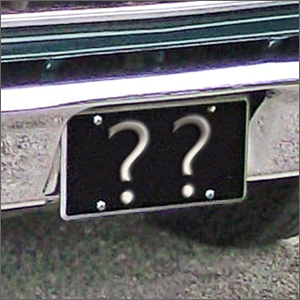 | |
 My wife and I had an older Mercedes-Benz Diesel that we drove for years, I grew up working on cars and do all my own work and service. My wife began telling me that for some reason the car was down on power and acceleration, or at least less than the normal underpowered non-turbo diesel usually had. I took it for a drive and determined in my mind something had happened to the injection pump and assured my wife I would look into it when I had time. Meanwhile she found ways to avoid hills and highways. Much to my wife's relief, I eventually found the time to take a look at the car and headed out to the garage. I was back less than five minutes later with my head hung low in shame, shuffling my feet and avoiding eye contact. The last time I changed the oil, just prior to the problem being reported, I bumped the linkage off that controls the butterfly valve that allows air into the engine, leaving the valve closed all the time. I snapped the linkage back into place and all went back to normal. Lesson learned, think back to what may have changed and why when troubleshooting a problem. It has been a joke in our family ever since, "Any oil changes lately?" Dan in B.C., Canada Share Your Story |
|
 Earlier this summer, I was marveling how clean the garage floor was staying below my '86 Mustang since I had replaced the oil pan and valve cover gaskets when I noticed a small drop of coolant. After the next short drive, there was an obvious stream of coolant coming out of the engine's failing water pump pulley seal. Slowly disappearing coolant mysteries are often solved when an unseen tiny radiator, hose, heater core or water pump leak quickly grows into an easy-to-trace puddle. To locate persistently hard-to-find coolant leaks, you might try adding fluorescent dye to the cooling system and using a UV flashlight to detect leaking coolant/dye. Dye can reveal the source of slow leaks that have been evaporating away or getting camouflaged by rainwater or greasy surfaces. Dye can also uncover many small leaks such as when a radiator has multiple pin-prick-sized corrosion holes. 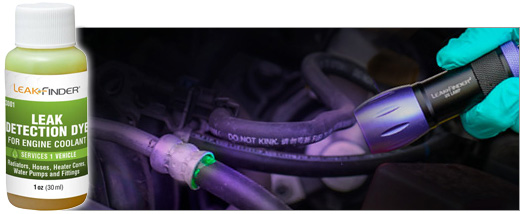 Fluorescent Dye & UV Flashlight When there is no sign of an external leak, but the cooling system continues to need coolant added to it, then the coolant may be leaking inside the engine because a head gasket is blown, a plastic intake manifold has warped, a head has cracked or the cooling system plumbing has been otherwise breached so that leaking coolant flows into other parts of the engine rather than onto the ground. Coolant that has leaked into the crankcase will usually be visible as streaks of light colored slime in the engine oil. Coolant that has leaked into the exhaust may appear as white smoke exiting the tailpipe. A significant internal leak may lower the compression in one or more cylinders. That may lead to the engine computer setting a misfire trouble code. A compression tester gauge fitting inserted in the spark plug holes one at a time may show one or more of the cylinders has lower compression than the rest. Coolant residue on the problem cylinder's spark plug electrode may look different than the deposits on the other spark plugs' electrodes. 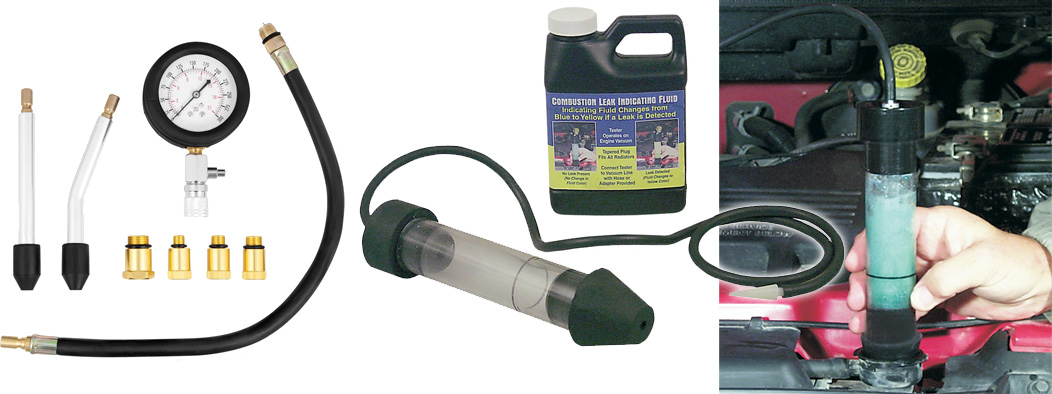 Compression Tester & Combustion Leak Detector A leak may also cause engine oil, air and/or combustion gases to seep into the cooling system. Combustion gas is under high pressure that may make it the most likely to be forced through a leak into the cooling system. A simple combustion leak detector can be inserted into the radiator cap opening to check for combustion gases that have leaked into the cooling system. Follow the instructions that come with the tool (tools are found under the "Tools & Universal Parts" tab in the RockAuto.com catalog). Bromothymol blue chemical poured into the tool quickly changes to a yellow color after any combustion gases present in the radiator change the chemical's composition/pH. (If there is no combustion gas in the radiator, then celebrate by taking the tool to the tailpipe and watch the exhaust gas there turn the chemical yellow!) Tom Taylor, To read more of Tom's articles, click this link and choose from story titles on the Newsletter Archives page. |
|
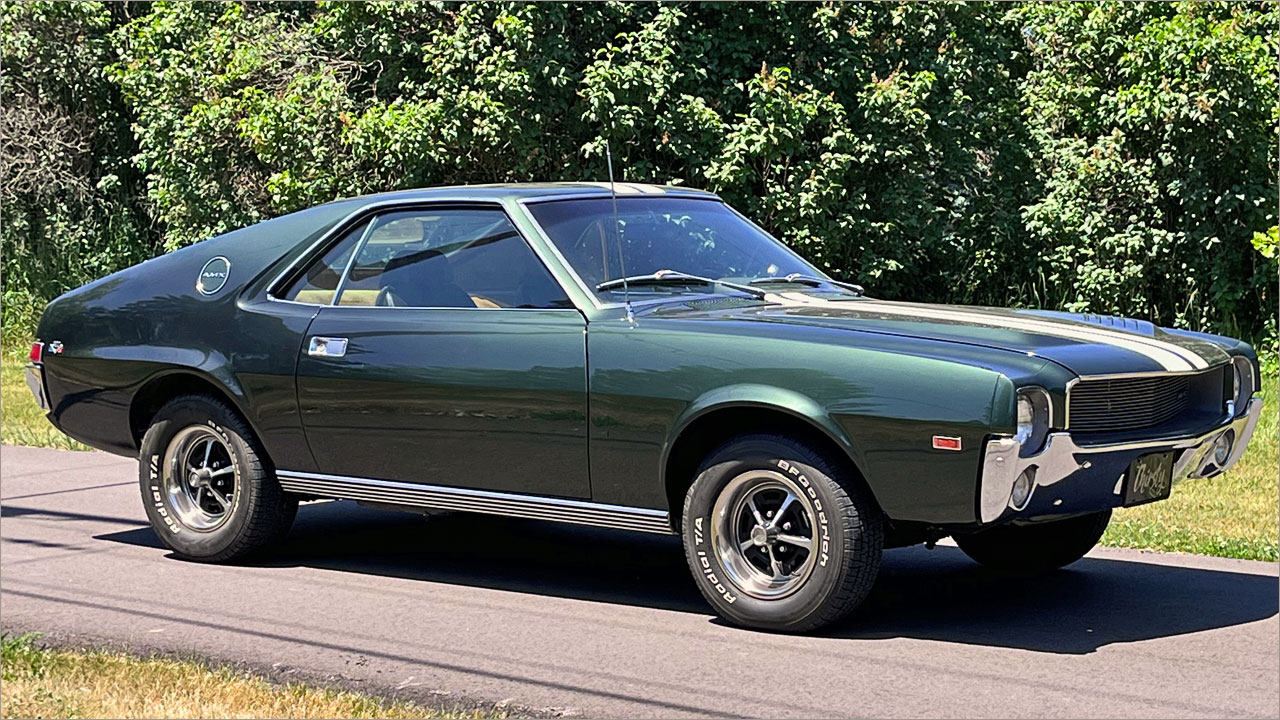 |
|
This is my 1969 AMC AMX I purchased in 2021. It was the same model and year car my father owned in the early 1970s. He sold his AMC and bought a Mercury Montego wagon when my parents needed room for a third kid in the family. As I got older, and he told me about his good times with the AMX, I promised him that he and I would go for a ride in an AMX one day. He was diagnosed with Leukemia in August of 2021, and that's what got me motivated to find and acquire this beautiful ride, with the same "saddle" interior, "Go Pak", 390 V8 with a four speed manual just like he had. From RockAuto, I've purchased various parts like relays, switches, lights, a carburetor rebuild kit, and a full rear brake rebuild. RockAuto even had the parking brake cables! I can now park on hills with confidence. Jeremy in Michigan |
Share Your Hard Work And Stories | |
|
Your Hard Work Your Most Infamous Auto Repair Blunder | |




 ) to your cart to take advantage of this 10% instant manufacturer rebate and save even more on
) to your cart to take advantage of this 10% instant manufacturer rebate and save even more on 